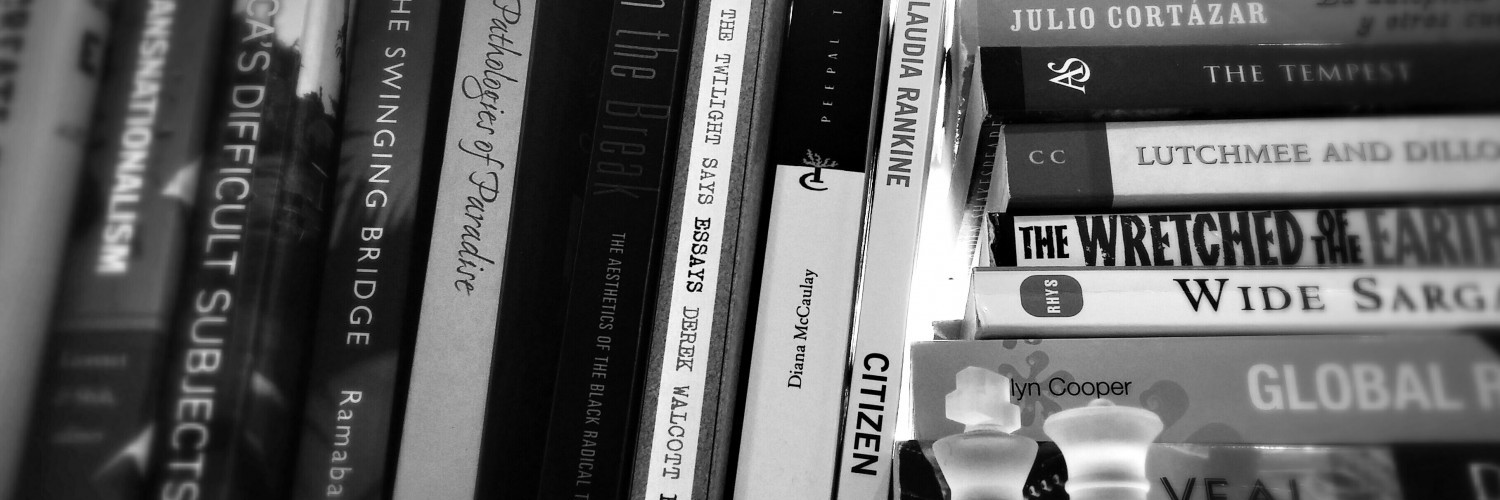Once, in a game we were playing, something terrible happened. A man had recently killed his girlfriend and a man who was his best friend when he found them drinking together in a bar. Their blood splattered all over him. The cutlass he had used to kill them in hand, he walked the mile or so to the police station with the other customers of the bar and some people they picked up along the way. The murder of these two people immediately became a big scandal, and the most popular calypso song that year was all about it. […] Everybody wondered if he would be hanged, which was the penalty for murder; also it became a scandal because everyone had known the woman and all had predicted that she would come to a bad end. Everything about this soon became a spectacle. During the funerals of the murdered man and woman, people lined the streets and followed the hearses from the church to the cemetery. During the trial of the murderer, the courtroom was always packed. […] On the morning that he was hanged, people gathered outside the jail and waited until the jail’s church bell rang, showing that the hanging was completed. (pages 96-7, my emphasis)
In 1983 Jamaica Kincaid, the Antiguan-born author of Caribbean fiction and non-fiction, wrote a beautifully complicated story about a little girl and her introspective path to independence. Annie John, from which I quoted at length above, is a novel steeped with post-colonial discontent, pubescent angst, and the yearning to be something called free. Annie John and her friend Mineu are so enthralled by the community’s response to what can only be described as a heinous act of domestic violence that, in their childish naivete they decide to take the spectacle further by reenacting both the murder and the murderer’s punishment.
When it came to the hanging, we wanted that to be real, too, so Mineu had found a piece of rope and tied it to the top bar of the gate to his yard, and then he would make a noose and put his head in it. When the noose was around his neck, he would grab the rope from above and then swing on it back and forth to show that he was hanged and already dead. All of our playing together came to an end when something bad almost happened. We were playing in the usual way when we came to the part of the noose around the neck. When he lifted himself off the ground, the noose tightened. When he let go of the rope to loosen the noose with his hands, that only made matters worse, and the noose tightened even more. His mouth opened as he tried to get breath, and then his tongue began to come out of his mouth. His body, hanging from the gate, began to swing back and forth, and as it did it banged against the gate, and it made a sound as if he were swinging on the gate—the very thing we were always being told not to do. As all this happened, I just stood there and stared. (page 98)
Re-reading Annie John this morning I had to pause because Annie reminded me that the miscommunication of abuse and death is not new. For a long time now we have been staring at this violence that has served as a guilty spectacle in Caribbean society.
Here in Jamaica we have been gripped two weekends in a row with news of young women – girls – who have been taken, raped, slaughtered, and discarded. These women – these girls – whose bodies have suffered under the sexual aggression of rapists, and the violent aggression of murderers, these women – these girls – have been stripped of their right to rest in peace. Sadly, these women – these girls – have been made to suffer doubly under the post-mortem gaze of the spectator as images of decomposing flesh, alleged to be theirs, is circulated via social media and messaging apps. Sure we shouldn’t shoot the messenger, but why are we sending these images? What are we communicating when we do not speak 15 year old Shanika Gray’s name; but, instead, we stare at a terrifying image of her bare flesh on our mobile devices? What are we communicating when we do not speak Nile Brown’s name; but, instead we stare at an unfathomable image of her naked flesh on our palm-held devices? How are we not complicit in the misuse of their bodies?
I spoke to one man this morning who seemed some what eager to “break the news” to me. His demeanor told me that he was troubled by the “wickedness” that he said is “sweeping the nation,” but his readiness to tell the story suggested a quiet satisfaction at being the one able to pass along the (misuse of) information. What troubled me further was that he could not name Ms. Brown or Ms. Gray as the victims. He could only speak of these women – these girls – using the descriptors that their Whatsapp broadcasted images provided. Shanika Gray became “the one in the skirt” and Nile Brown became “the one in the cut pants” and “the one in the blue barrel.” Message broadcasting, group texts, Instagram, and any other social media that delivers an announcement of death in this gruesome way is doing an injustice both to the deceased and the bereaved. Honestly, can you fathom the idea of having an image of your loved one’s decomposing and tortured body being forwarded around like a party promotion or uploaded to a website for the world to behold?
If I press the issue it is possible to consider that this may be a barbaric legacy that some individuals have decided to resurrect and modernize. Or, perhaps, it is a barbaric legacy that simply never left. I am reminded of that frightful scene in Annie John where the spectacle of violence both desensitizes and paralyzes Annie and almost costs here friend his life. I am also reminded that in 1760 the enslaved Coromantee rebel leader Tacky, was killed then decapitated and his head was mounted on a pole in Spanish Town, Jamaica as a warning to all slaves that this kind of death and shaming would be their fate if they chose to rebel. In 2017, circulating the image of the victimized deceased has become spectacle and an opportunity to shock and frighten the onlooker. We stare at these women’s tortured bodies telling ourselves that we are grieving them. But are we? Why are the majority of these broadcasts, messages, and social media posts images of the innocent? And, no, circulating images of these savage criminals is not the answer either as that will likely just precipitate the kind of vigilante justice that Jamaica needs less of. Rather, the message that needs to be communicated to our communities, to our women, to our girls is a necessary message about caution, protection, empowerment, and self-defense.
This is not how we mourn. Making a spectacle of the victim is not how we ought to warn our citizens that rapists and murderers are among us. This is abuse. We must do better by Ms. Gray and Ms. Brown and all of the unnamed, lost, and forgotten women and girls who have been assaulted, raped, silenced, and senselessly killed.
Rest in peace to all who have suffered not once but twice because of the spectator’s gaze. We can do better. We must do better.
“Good friends we have, oh, good friends we’ve lost
Along the way.
In this great future, you can’t forget your past,
So dry your tears, I say.”
Yes woman yes cry.
The protest continues.


I think its fair that we feel our feelings. However, our environment has plagued us with the permanent gun shots possible heard at anytime, day or night. And don’t get me started on the News, media is extremely powerful. I am desensitized to violence. I’m ashamed to share this truth.
LikeLike
Don’t feel ashamed. These truths matter and help us to accurately assess ourselves and our reality.
LikeLike